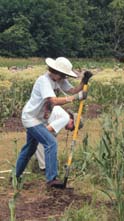

Volunteer digging in soil filled with root material of prairie plants.
"Papa needs five horses for the big gang plow," Caleb told Sarah. "Prairie grass is hard."
- from Patricia MacLachlan's Sarah Plain and Tall
Prairie plants and grasses have BIG ROOTS-- many times larger than the parts of the plants that you see above ground. The deep root systems help prairie plants survive extreme heat, droughts, and fires.
Large root systems help prairie plants draw any available moisture from deep underground so they can withstand droughts.
If they cannot find enough moisture for the plant to continue growing, the part of the plant above ground turns brown and dries off, but the root system and growing point remain alive under ground.
Grasses growing on lawns work in much the same way. The tops of grass becomes brown and dried out in the intense summer heat. In the fall, as the air cools down and there is more rain, grass comes up green again.
|
|
Copyright © 2000 Illinois State Museum